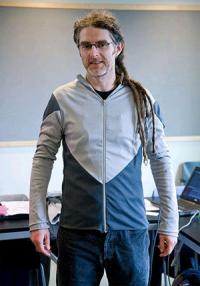Haptic jacket lets you feel the movies

Imagine watching Apocalypto and feeling the pounding heart of the escaping protagonist tribesman on your own chest? That's now possible with a haptic jacket lined with vibration motors that researchers demoed at last week’s IEEE-sponsored 2009 World Haptics Conference in Salt Lake City.
The jacket, created by Philips Electronics, is meant to study the effects of touch on a movie viewer’s emotional response to what the characters are experiencing. It is not meant to translate blows like kicks and punches, although it can simulate outside forces. Their goal is to investigate emotional immersion.
“People don’t realize how sensitive we are to touch, although it is the first sense that fetuses develop in the womb,” said Paul Lemmens, a Philips senior scientist who conducted research with the jacket.

Credit: Steve Brewster
According to IEEE Spectrum, the garment contains 64 independently controlled actuators distributed across the arms and torso. The actuators are arrayed in 16 groups of four and linked along a serial bus. And each group shares a microprocessor. The jacket’s power consumption is very low as the actuators draw little current, allowing for one hour of operation on its two AA batteries, even if the system was continuously driving 20 of the motors simultaneously.
Lemmens, uses the Kung Fu expert Bruce Lee in his explanation of their goals. "We want people to feel Bruce Lee’s anxiety about whether he will get out alive. The jacket, responding to signals encoded in the DVD or to a program designed to control the jacket on the fly, can do a host of things, such as 'causing a shiver to go up the viewer’s spine and creating the feeling of tension in the limbs'."
The IEEE article explains that the actuators are capable of cycling on and off 100 times per second, which is more than enough to outpace the refresh rate of a computer screen or a TV set. But how does it stimulate the entire upper body using only 64 actuators? According to Lemmens, the skin’s neural wiring and the way the brain perceives touch make that number sufficient. "Though the jacket has only eight actuators along the length of each sleeve (four in front and four in back) spaced about 15 centimeters apart, those actuators can create the sensation that the arm is being tapped in several spots between the motors (a phenomenon called the cutaneous rabbit illusion)."
Apparently, there are no matching set of pants in the works, but the Philips researcher says that the possible applications of the technology are limitless and that the emotion-inducing actuators could go anywhere.
That's good news for those who want to see haptics play a bigger role in virtual reality systems. While headway has been made in areas like game controls such as the Wii and a host of other stylus-based devices like this dental modeling system, touch is lagging sight and sound, but not taste and smell. A VR system that can simuate all five senses is a long way off, but researchers are making baby steps as this video shows.